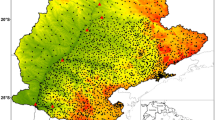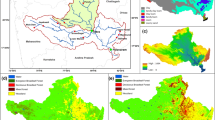Abstract
The West Flowing River Basins from Tadri to Kanyakumari (WFRB-2), India, is a highly complex hydrological system witnessing hydrological extremes frequently. In this study, the impacts of climate/Land Use Land Cover (LULC) changes on hydrology in WFRB-2 are investigated on a 0.25° spatial scale for a historic (1979–2018) time period. Six major river basins are chosen in the upper, middle and lower regions of WFRB-2 and the variable infiltration capacity (VIC) model is calibrated using SCE-UA (Shuffle Complex Evolution) algorithm. The linear trend analysis showed a significant increase in premonsoon/monsoon rainfall in the lower region and a 13% increase in the percentage of very wet years, while dry years completely disappeared in the recent past. Sensitivity analysis shows that annual mean surface runoff (SR) increases by 125 mm and evapotranspiration (ET) decreases by 562 mm when a fully forested grid was transformed into a fully built-up grid. Similarly, sensitivity towards rainfall alone is showing an increase of SR and ET by 54 mm (6%) and 64 mm (6%) respectively. Overall impact results in a reduction in the annual mean total runoff by 48 mm in the upper and 100 mm in the middle and a rise of 53 mm in the lower regions. This shows that in the lower region, with an increase in precipitation coupled with increasing urbanization, there is a possibility of greater magnitude flood peaks. This study is useful to understand the complex hydrological impacts due to climate/LULC changes for management decisions on a regional scale.

Source: Decadal LULC classification from Landsat 4, 5 based on Roy et al. 2015) and 2016 (from Landsat 8)





Similar content being viewed by others
References
Bowling LC, Pomeroy JW, Lettenmaier DP (2004) Parameterization of blowing-snow sublimation in a macroscale hydrology model. J Hydrometeorol 5(5):745–762. https://doi.org/10.1175/1525-7541(2004)005%3c0745:POBSIA%3e2.0.CO;2
Census of India (2011) Population enumeration data (final population). http://www.censusindia.gov.in/2011census/population_enumeration.html. Accessed on 21 October 2021
Chattopadhyay S (1985) Deforestation in parts of Western Ghats region (Kerala). India J Environ Manag 20(3):219–230
Chawla I, Mujumdar PP (2015) Isolating the impacts of land use and climate change on streamflow. Hydrol Earth Syst Sci 19:3633–3651. https://doi.org/10.5194/hess-19-3633-2015,2015
Cuo L, Zhang Y, Gao Y, Hao Z, Cairang L (2013) The impacts of climate change and land cover/use transition on the hydrology in the upper Yellow River Basin, China. J Hydrol 502:37–52. https://doi.org/10.1016/j.jhydrol.2013.08.003
CWC (Central Water Commission) (2017) Reassessment of water availability in India using space inputs. Basin Planning and Management Organisation, Central Water Commission, New Delhi India. http://www.cwc.gov.in/publications
Das J, Umamahesh NV (2016) Downscaling monsoon rainfall over river Godavari Basin under different climate-change scenarios. Water Resour Manag 30(15):5575–5587. https://doi.org/10.1007/s11269-016-1549-6
Das P, Behera MD, Patidar N, Sahoo B, Tripathi P et al (2018) Impact of LULC change on the runoff, base flow and evapotranspiration dynamics in eastern Indian river basins during 1985–2005 using variable infiltration capacity approach. J Earth Syst Sci 127(2):1–19. https://doi.org/10.1007/s12040-018-0921-8
Deng X, Shi Q, Zhang Q, Shi C, Yin F et al (2015) Impacts of land use and land cover changes on surface energy and water balance in the Heihe River Basin of China, 2000–2010. Phys Chem Earth A/B/C 79:2–10. https://doi.org/10.1016/j.pce.2015.01.002
Duan Q, Sorooshian S, Gupta VK (1994) Optimal use of the SCE-UA global optimization method for calibrating watershed models. J Hydrol 158(3–4):465–284. https://doi.org/10.1016/0022-1694(94)90057-4
Gao H, Bohn TJ, Podest E, McDonald KC, Lettenmaier DP et al (2011) On the causes of the shrinking of Lake Chad. Environ Res Lett 6(3):034021. https://doi.org/10.1088/1748-9326/6/3/034021
Garcia‐Carreras L, Parker DJ (2011) How does local tropical deforestation affect rainfall? Geophys Res Let 38(19). https://doi.org/10.1029/2011GL049099
Garg V, Aggarwal SP, Gupta PK, Nikam BR, Thakur PK et al (2017) Assessment of land use land cover change impact on hydrological regime of a basin. Environ Earth Sci 76:635. https://doi.org/10.1007/s12665-017-6976-z
Garg V, Nikam BR, Thakur PK, Aggarwal SP, Gupta PK et al (2019) Human-induced land use land cover change and its impact on hydrology. Hydro Res 1:48–56. https://doi.org/10.1016/j.hydres.2019.06.001
Gosain AK, Rao S, Basuray D (2006) Climate change impact assessment on hydrology of Indian river basins. Curr Sci 346–353. http://www.jstor.org/stable/24091868
Gregory KJ (2006) The human role in changing river channels. Geomorphology 79(3–4):172–191. https://doi.org/10.1016/j.geomorph.2006.06.018
Haddeland I, Lettenmaier DP, Skaugen T (2006) Effects of irrigation on the water and energy balances of the Colorado and Mekong river basins. J Hydrol 324(1–4):210–223. https://doi.org/10.1016/j.jhydrol.2005.09.028
Hengade N, Eldho TI (2019) Relative impact of recent climate and land cover changes in the Godavari river basin, India. J Earth Syst Sci 128(4). https://doi.org/10.1007/s12040-019-1135-4
IPCC (2007) Climate Change 2007: Synthesis Report Contribution of Working Groups I, II and III to the Fourth Assessment Report of the Intergovernmental Panel on Climate Change. Core Writing Team, Pachauri RK and Reisinger A (eds). IPCC, Geneva, Switzerland
Jain SK, Kumar V, Saharia M (2013) Analysis of rainfall and temperature trends in northeast India. Int J Climatol 33(4):968–978. https://doi.org/10.1002/joc.3483
Jodar-Abellan A, Valdes-Abellan J, Pla C, Gomariz-Castillo F (2019) Impact of land use changes on flash flood prediction using a sub-daily SWAT model in five Mediterranean ungauged watersheds (SE Spain). Sci Total Environ 657:1578–1591. https://doi.org/10.1016/j.scitotenv.2018.12.034
Kay AL, Davies HN, Lane RA, Rudd AC, Bell VA et al (2021) Grid-based simulation of river flows in Northern Ireland: model performance and future flow changes. J Hydrol Reg Stud 38:100967. https://doi.org/10.1016/j.ejrh.2021.100967
Krishnakumar KN, Rao GP, Gopakumar CS (2009) Rainfall trends in twentieth-century over Kerala, India. Atmos Environ 43(11):1940–1944. https://doi.org/10.1016/j.atmosenv.2008.12.053
Kumar N, Tischbein B, Kusche J, Beg MK, Bogardi JJ et al (2017) Impact of land-use change on the water resources of the Upper Kharun Catchment, Chhattisgarh, India. Reg Environ Chang 17(8):2373–2385. https://doi.org/10.1007/s10113-017-1165-x
L’hote Y, Mahé G, Somé B, Triboulet JP (2002) Analysis of a Sahelian annual rainfall index from 1896 to 2000; the drought continues. Hydrol Sci J 47(4):563–572. https://doi.org/10.1080/02626660209492960
Liang X, Lettenmaier DP, Wood EF (1996) One-dimensional statistical dynamic representation of subgrid variability of precipitation in the two-layer variable infiltration capacity model. J Geophys Res Atmos 101(D16):21403–21421. https://doi.org/10.1029/96JD01448
Lin W, Zhang L, Du D, Yang L, Lin H et al (2009) Quantification of land use/land cover changes in Pearl River Delta and its impact on regional climate in summer using numerical modeling. Reg Environ Chang 9(2):75–82. https://doi.org/10.1007/s10113-008-0057-5
Liu X, Xu Z, Liu W, Liu L (2019) Responses of hydrological processes to climate change in the Yarlung Zangbo River basin. Hydrol Sci J 64(16):2057–2067. https://doi.org/10.1080/02626667.2019.1662908
Lohmann DA, Nolte-Holube RA, Raschke E (1996) A large scale horizontal routing model to be coupled to land surface parameterization schemes. Tellus A 48(5):708–721. https://doi.org/10.1034/j.1600-0870.1996.t01-3-00009.x
Mishra D, Sahu NC, Sahoo D (2016) Impact of climate change on agricultural production of Odisha (India): a Ricardian analysis. Reg Environ Chang 16(2):575–584. https://doi.org/10.1007/s10113-015-0774-5
Mondal A, Khare D, Kundu S (2015) Spatial and temporal analysis of rainfall and temperature trend of India. Theor Appl Climatol 122(1):143–158. https://doi.org/10.1007/s00704-014-1283-z
Moriasi DN, Arnold JG, Van Liew MW, Bingner RL, Harmel RD et al (2007) Model evaluation guidelines for systematic quantification of accuracy in watershed simulations. Trans ASABE 50(3):885–900. https://doi.org/10.13031/2013.23153
Nair SC (1991) The southern Western Ghats: a biodiversity conservation plan (No. 4). Indian National Trust for Art and Cultural Heritage
Nandi S, Manne JR (2020) Spatiotemporal analysis of water balance components and their projected changes in near-future under climate change over Sina Basin, India. Water Resour Manag 34:2657–2675. https://doi.org/10.1007/s11269-020-02551-2
Nash JE, Sutcliffe JV (1970) River flow forecasting through conceptual models part I—a discussion of principles. J Hydrol 10(3):282–290. https://doi.org/10.1016/0022-1694(70)90255-6
Nijssen B, Lettenmaier DP, Liang X, Wetzel SW, Wood EF et al (1997) Streamflow simulation for continental-scale river basins. Water Resour Res 33(4):711–724. https://doi.org/10.1029/96WR03517
Nijssen B, O’Donnell GM, Hamlet AF, Lettenmaier DP (2001) Hydrologic sensitivity of global rivers to climate change. Clim Chang 50(1):143–175. https://doi.org/10.1023/A:1010616428763
Patidar N, Behera MD (2019) How significantly do land use and land cover (LULC) changes influence the water balance of a river basin? A study in Ganga river basin, India. Proc Natl Acad Sci India Sect A 89(2):353–365. https://doi.org/10.1007/s40010-017-0426-x
Paul S, Ghosh S, Rajendran K, Murtugudde R (2018) Moisture supply from the Western Ghats forests to water deficit east coast of India. Geophys Res Lett 45(9):4337–4344. https://doi.org/10.1029/2018GL078198
Prasad VK, Badarinath KV, Eaturu A (2008) Effects of precipitation, temperature and topographic parameters on evergreen vegetation greenery in the Western Ghats, India. Int J Climatol 28(13):1807–1819. https://doi.org/10.1002/joc.1662
Rajendran K, Kitoh A (2008) Indian summer monsoon in future climate projection by a super high-resolution global model. Curr Sci 1560–1569. http://www.jstor.org/stable/24105513
Rajendran K, Kitoh A, Srinivasan J, Mizuta R, Krishnan R et al (2012) Monsoon circulation interaction with Western Ghats orography under changing climate. Theor Appl Climatol 110(4):555–571. https://doi.org/10.1007/s00704-012-0690-2
Ramachandran TV, Uttam Kumar, Anandita Dasgupta (2017) Reduction in forest area has led to deficit rainfall, Deccan Herald News paper. http://www.deccanherald.com/content/565499/reduction- forest-area-has-led.html (Accessed: 19 March 2021)
Reddy CS, Jha CS, Dadhwal VK (2016) Assessment and monitoring of long-term forest cover changes (1920–2013) in Western Ghats biodiversity hotspot. J Earth Syst Sci 125(1):103–114. https://doi.org/10.1007/s12040-015-0645-y
Risal A, Parajuli PB, Dash P, Ouyang Y, Linhoss A et al (2020) Sensitivity of hydrology and water quality to variation in land use and land cover data. Agric Water Manag 241:106366. https://doi.org/10.1016/j.agwat.2020.106366
Roy PS, Roy A, Joshi PK, Kale MP, Srivastava VK et al (2015) Development of decadal (1985–1995–2005) land use and land cover database for India. Remote Sens 7(3):2401–2430. https://doi.org/10.3390/rs70302401
Saranya P, Krishnakumar A, Sinha N, Kumar S, Krishnan KA et al (2021) Isotopic signatures of moisture recycling and evaporation processes along the Western Ghats orography. Atmos Res 264:105863. https://doi.org/10.1016/j.atmosres.2021.105863
Singh KK, Pal M, Singh VP (2010) Estimation of mean annual flood in Indian catchments using backpropagation neural network and M5 model tree. Water Resour Manag 24(10):2007–2019. https://doi.org/10.1007/s11269-009-9535-x
Sinha RK, Eldho TI (2018) Effects of historical and projected land use/cover change on runoff and sediment yield in the Netravati river basin, Western Ghats, India. Environ Earth Sci 77(3):1–19. https://doi.org/10.1007/s12665-018-7317-6
Soman MK, Kumar Krishna K, Singh N (1988) Decreasing trend in the rainfall of Kerala. Curr Sci 97(1):7–12
Tawde SA, Singh C (2015) Investigation of orographic features influencing spatial distribution of rainfall over the Western Ghats of India using satellite data. Int J Climatol 35(9):2280–2293. https://doi.org/10.1002/joc.4146
Torres C, Jordà G, de Vílchez P, Vaquer-Sunyer R, Rita J et al (2021) Climate change and their impacts in the Balearic Islands: a guide for policy design in Mediterranean regions. Reg Environ Chang 21(4):1–19. https://doi.org/10.1007/s10113-021-01810-1
Trang NT, Shrestha S, Shrestha M, Datta A, Kawasaki A (2017) Evaluating the impacts of climate and land-use change on the hydrology and nutrient yield in a transboundary river basin: a case study in the 3S River Basin (Sekong, Sesan, and Srepok). Sci Total Environ 576:586–598. https://doi.org/10.1016/j.scitotenv.2016.10.138
Warburton ML, Schulze RE, Jewitt GP (2012) Hydrological impacts of land use change in three diverse South African catchments. J Hydrol 414:118–135. https://doi.org/10.1016/j.jhydrol.2011.10.028
WGEEP (2011) Report of Western Ghat Ecological Expert Panel Part 1, submitted to Ministry of Environment and Forests, Govt. of India, New Delhi. https://www.cppr.in/wp-content/uploads/2013/03/Gadgil-report.pdf
Yira Y, Diekkrüger B, Steup G, Bossa AY (2016) Modeling land use change impacts on water resources in a tropical West African catchment. J Hydrol 537:187–199. https://doi.org/10.1016/j.jhydrol.2016.03.052
Acknowledgements
The authors wish to express our deep gratitude to the Central Water Commission and Indian Meteorological Department for providing hydrological and meteorological data. The authors are thankful to the Editor and reviewers for their valuable comments which helped to improve the manuscript.
Funding
The authors also acknowledge the sponsorship of the project (17MWR0009-001) entitled ‘Impacts of Climate Change on Water Resources in River Basin from Tadri to Kanyakumari’ by INCCC, Ministry of Water Resources, Govt. of India.
Author information
Authors and Affiliations
Corresponding author
Additional information
Communicated by Wolfgang Cramer
Publisher's Note
Springer Nature remains neutral with regard to jurisdictional claims in published maps and institutional affiliations.
Supplementary Information
Below is the link to the electronic supplementary material.
Rights and permissions
About this article
Cite this article
Chandu, N., Eldho, T.I. & Mondal, A. Hydrological impacts of climate and land-use change in Western Ghats, India. Reg Environ Change 22, 32 (2022). https://doi.org/10.1007/s10113-022-01879-2
Received:
Accepted:
Published:
DOI: https://doi.org/10.1007/s10113-022-01879-2




